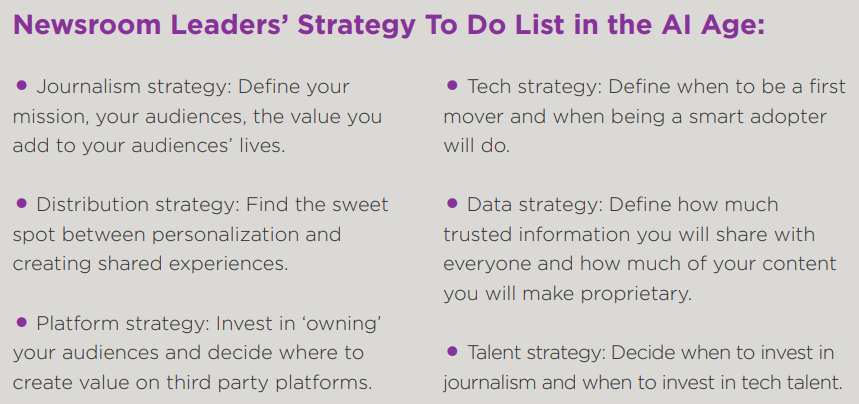When looking at larger publishing trends as much as I do in my Magazine Manager blogs, it’s easy to get too focused on the numbers.
Even as I opine and offer insights from years of first-hand publishing and software experience, much reverence is paid to the trending percentages and top-ranked considerations provided by large sample-sizes of survey respondents and data crunches.
So to tackle a case-study report on a mere 20 interviews of newsroom leaders, well, it better hit a particularly sweet spot.
And EBU’s latest breakdown, which covers publishing and AI, absolutely ticks many of those sweet-spot boxes for me.
MediaPost’s Ray Schultz first opened my eyes to the “Leading Newsrooms In The Age of Generative AI” report, commenting on its “over the top” opening — “Do we realize how lucky we are?” EBU News’ Eric Scherer writes in the foreword, “to be alive at a time as important as the arrival of the printing press, Michelangelo or Leonardo da Vinci!” — and then pointing to such hyperbole-disqualifying concerns as Big Tech prioritizing speed over ethical worries (which the report attributes to “the political shift in the US”).
But within the insights provided even from that small sample size of newsrooms, there are clearly gems that speak to a larger, overall sentiment.

Strategies from “Leading Newsrooms In The Age of Generative AI” (Source: EBU)
AI Interest
“Newsroom leaders are generally happy with the extent to which staff is interested in AI, and ready to experiment with and use AI tools,” the report says, dismissing concerns about divisions within the newsroom. “But there are worries about laziness and hidden usage of certain AI tools. Others think newsrooms worry too much about efficiency improvements and invest too little in equipping journalists to tell better stories with the support of AI.”
Giving more time and transparency to how AI can and will be used is something that can benefit both storytellers and audiences alike. And while the most cautious staffers may err on the side of complete disclosure, it’s on leadership to set that tone and standard across the company.
Once that’s firmly set, the audience will follow suit. As the report puts it, “it will be essential for media organizations to be a trusted partner of the audiences they serve.”
AI Applications
“Newsroom leaders are generally quite satisfied with using generative AI tools for everyday tasks that don’t require perfect results, like translation, transcription, and subtitling,” the report shares. “They have observed massive quality improvements and feel they can serve audiences better with less effort.”
Indeed, when AI is used for complementary-yet-still-front-facing purposes such as those, there does feel like some leeway is allowed and acceptable, at least initially.
And as those on staff work with these tools more, their comfort will accompany the ever-improving outputs to ensure better overall results.
AI With Oversight
“Newsrooms still consider having a ‘human in the loop’ necessary, perhaps even an asset.”
The report admits that the human-oversight factor does “constrain the scaling at speed that AI promises,” but publishers don’t need to strain their brains all that hard to imagine the alternative. Just earlier this week, readers saw the consequences of human-inaction with a Chicago Sun-Times story that ran book recommendations for nonexistent, AI-hallucinated titles.
When humans merely prompt, copy-and-paste, and print, it’s only their failure that’s on full display.
And carried out over time, be it on big or small scales, these indiscretions turn into more than a punchline; they become derailing hindrances for what so many humans do genuinely hope is a revolutionary moment.
“So, yes, we’re glad and lucky to be living in historic times,” says Scherer. “But, in an area so central to our democracies, beware of the elephant in the room: the loss of human control.”
No matter how much attention you pay to the numbers and trends, the humans ultimately tell the story.
SEE FOR YOURSELF
The Magazine Manager is a web-based CRM solution designed to help digital and print publishers manage sales, production, and marketing in a centralized platform.





